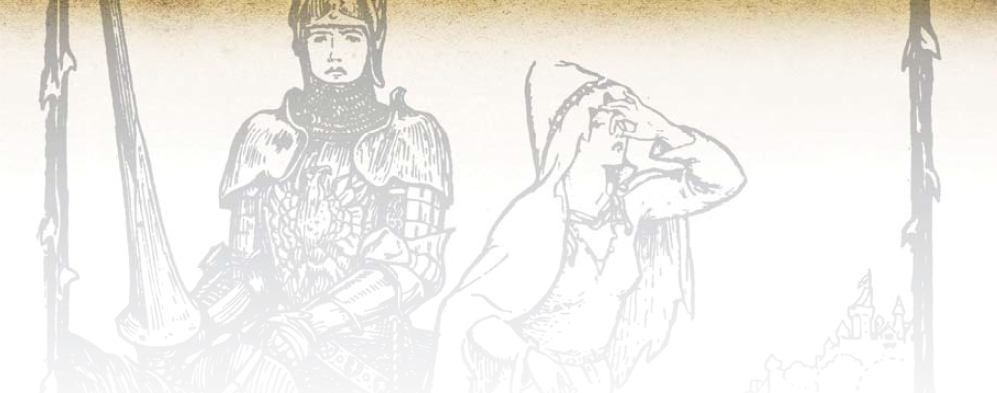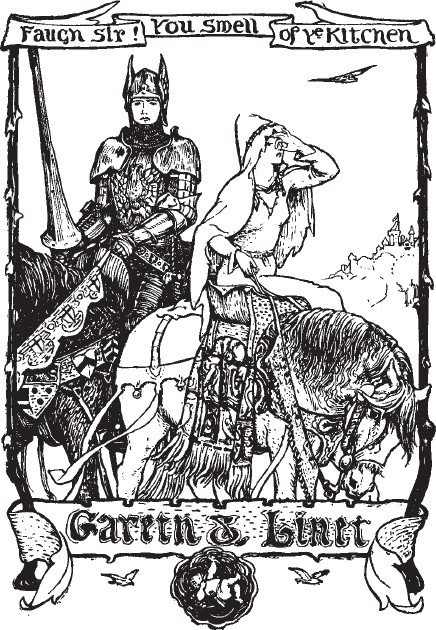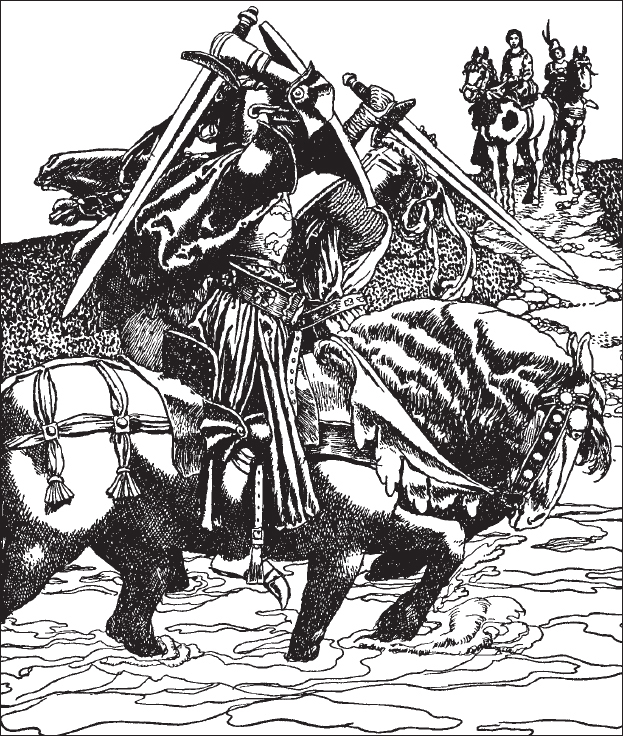

BEAUMAINS: THE KNIGHT OF THE KITCHEN
No sooner had the young man had arrived at Camelot asking to serve Arthur as a knight than he was put to work in the pungent kitchens by Kay, Arthur’s imperious stepbrother and steward. As he had no name, Kay mockingly dubbed him Beaumains: meaning ‘fair hands’, as befitted such a gentle young man. Instead of using his sword arm to uphold the laws of Arthur, Beaumains’ blade was the fish knife he used to gut trout. Kay reminded him of this every day for a year.
Not all of Arthur’s knights were so unkind to Beaumains. Lancelot understood that the kitchen boy wanted to serve the king with honour, and intervened whenever he witnessed Kay’s cruelty. For his part, Kay insisted that the boy was ill-bred and not fit to be a knight, for instead of asking Arthur for armour and a horse he had simply asked for food and lodgings. Despite Kay’s constant spite, Beaumains showed himself to be of good manners and temperament and he thrived as one of Camelot’s many servants.

‘Faugh sir! You smell of ye kitchen.’ Linet did not hide her disdain for Beaumains’ lowly rank with any subtlety. By HJ Ford.
A year to the day after Beaumains’ arrival, a lady named Linet entered Arthur’s Great Hall. Rather distraught, she explained to the king that Castle Perilous – home to her sister Lyonesse – was besieged by a tyrannical knight named Ironside. The very mention of this name caused a sharp intake of breath around the hall: known to many as the Knight of the Red Lands, Ironside was a terrifying beast of a warrior who had captured and slain several of Arthur’s knights. Linet begged for help to save her sister. Even the bravest of Arthur’s knights paused in silent unease.
Beaumains listened from the back of the hall, a tray of fish in his hands. As Linet asked a second time for a brave knight’s aid, he seized the moment. Putting the fish down and stepping forward, he made his own request of Arthur: to be knighted by Lancelot and to accompany Linet to save Lyonesse.
Pleased by the young man’s courage, and aware of his patient service in the kitchens, Arthur was delighted to grant Beaumains his request. Linet, repelled by her would-be hero’s fishy odour and offended that Arthur sent a mere servant to help her, stormed out of the hall and rode from Camelot.
Beaumains rummaged through Camelot’s old armoury and took a rusty mail coat, a musty yellowing surcoat, and a dusty lance. He rode out after Linet, closely followed by Kay and Lancelot. As the poorly clad knight drew alongside Linet’s horse, Kay began to mock him once again for the armour he had chosen. Enough was enough. Wheeling his horse about, Beaumains charged straight at Kay with a levelled lance and easily dislodged him from his saddle. Taking Kay’s sword, shield, and lance – all so much better than his own – Beaumains saw Lancelot approaching. Lancelot laughed at the sight of Kay miserably grovelling at the tip of his very own lance, and knighted Beaumains. To do so, he needed to know the young man’s real name and Beaumains told him: Gareth, a brother of Gawain. He had chosen to arrive at Camelot unknown, so that Arthur would judge him on merit more than on family reputation. He asked that Lancelot would not reveal his identity until he returned. Duly knighted, Gareth set off in pursuit of Linet who had ridden on without looking back.
When he drew his horse level beside Linet once again, she spoke to him in the same way that Kay had done for the past year. He was common, a coward for charging Kay unawares, and a varlet for stealing Kay’s shield and weapons. Nevertheless, Gareth insisted that he would ride with her, no matter how many insults she spat at him. He was a Knight of the Round Table and he would serve his king as well as he could. Linet rode on in silence, never looking at him nor speaking to him.
On the next day, they encountered a knight clad all in black. His black pavilion stood beside a black hawthorn tree, and his black-clad horse was tethered nearby. He called out a challenge to the approaching riders. The Black Knight asked Linet if Gareth was her champion; leaving Gareth behind, she rode up to the Black Knight and explained that he was merely a kitchen boy and no champion of hers. Perhaps, she said, the Black Knight could defeat him and become her champion?
The two knights set their horses at one another; lances crashed onto shields, and both warriors flew from their saddles. Jumping to their feet with swords drawn, they parried each other’s wild blows, until Gareth – fighting with the strength of a giant – battered his opponent to the ground. Gareth took his opponent’s black armour and black-clad horse, and ordered the knight to journey to Camelot to swear allegiance to Arthur. Linet and Gareth rode on. Linet continued to insult Gareth. She had not heard Gareth announce his true lineage to Lancelot.

Lady Linet explains to the Black Knight that the boy who accompanies her is barely worth fighting against, and is certainly not her champion. Beaumains sits atop his horse impassively awaiting combat; he carries an oddment of armour including Kay’s shield (based on D’Armagnac Armoral). In all of the plates in this book, the costume of unarmoured men and women is based upon late 12th- to early 14th-century British, French, and German dress; the weapons and equipment of most knights are from the middle of the 13th century, although some wear slightly older armour.

‘Sir Gareth doeth Battle with the Knight of the River Ford.’ By Howard Pyle. Many duels in Arthurian literature take place at a ford, and here Beaumains defeats the Blue Knight in one such fracas.
On the next day, they encountered a knight clad all in green, waiting beside a green pavilion with a green-clad horse tethered nearby. He called out to the approaching riders, mistaking Gareth for the Black Knight, his brother. Gareth replied that he was not that knight, but had defeated him the previous day. The Green Knight asked Linet if Gareth was her champion; she rode up to the Green Knight and explained that he was merely a kitchen boy and no champion of hers. Perhaps, she said, the Green Knight could defeat him and become her champion?
The two knights set their horses at one another; lances crashed onto shields, and both warriors flew from their saddles. Jumping to their feet with swords drawn, they parried each other’s wild blows, until Gareth once more battered his opponent to the ground. Gareth took his opponent’s green armour and green-clad horse, and ordered the knight to journey to Camelot to swear allegiance to Arthur. Linet and Gareth rode on. Linet once again mocked Gareth’s low status.
The following day, they encountered a knight clad all in red, waiting beside a red pavilion with a red-clad horse tethered nearby. He called out to the approaching riders, mistaking Gareth for the Green Knight, his brother. Gareth replied that he was not that knight, but had defeated him the previous day. The Red Knight asked Linet if Gareth was her champion; she rode up to the Red Knight and explained that he was merely a kitchen boy and no champion of hers. Perhaps, she said, the Red Knight could defeat him and become her champion?
As before, the knights clashed and Gareth defeated his opponent. He took his opponent’s red armour and red-clad horse, and ordered the knight to journey to Camelot to swear allegiance to Arthur. Linet and Gareth rode on once more. Linet mocked Gareth as the Knight of the Kitchen, a slayer of trout, and hero to the turnip.
Upon the next morning, they encountered a knight clad all in blue, waiting beside a blue pavilion next to a stream with a blue-clad horse tethered nearby. He called out to the approaching riders, mistaking Gareth for the Red Knight, his brother. Gareth replied that he was not that knight, but had defeated him the previous day. The Blue Knight asked Linet if Gareth was her champion; she rode up to the Blue Knight and explained that he was merely a kitchen boy and no champion of hers. Perhaps, she said, the Blue Knight could defeat him and become her champion?
As with the Blue Knight’s three brothers, a duel began. Wild blows were exchanged, until Gareth battered his opponent to the ground. Gareth took his opponent’s blue armour and blue-clad horse, and ordered the knight to journey to Camelot to swear allegiance to Arthur. Linet and Gareth rode on in silence.
Castle Perilous came into view early the next day, its towers rising high into the sky. Linet’s sister Lyonesse still held out against the encircling horde of Ironside’s army. Linet broke her silence to speak to Gareth, explaining that Ironside was renowned for possessing the strength of seven warriors. He had laid siege to the castle in the hope that Arthur’s knights would try to relieve it, allowing him to slay yet more Knights of the Round Table. Speaking more kindly than before, for he had served her well over the previous days and never once protested against her insults, Linet told Gareth that if he could defeat Ironside he would surely be known as one of the great knights in Logres.
Riding towards a huge pavilion set some distance from the castle walls, Gareth passed a timeworn tree from which bodies were hanging. He realized that the decaying corpses of some 40 of Arthur’s knights swung from nooses, victims of Ironside gruesomely displayed for all to see. Summoning enough courage to ride on, Gareth approached the tent and called out a challenge.
LE MORTE DARTHUR
Written in 15th-century England by a ‘knight prisoner’, Le Morte Darthur is perhaps the ultimate retelling of Arthurian legend. Building on many diverse sources – and substantially reworking or adding some original plots – the author Sir Thomas Malory describes not just the death of Arthur alluded to in the piece’s title, but the king’s rise to power and the deeds of those knights who served him.
Acting as a collator and translator, Malory most likely wrote his story of ‘King Arthur and his Noble Knights of the Round Table’ in the 1450s–70s, before it was renamed Le Morte Darthur (later corrected to Le Morte d’Arthur), then divided into books and chapters, and published by William Caxton in 1485.
Ironside emerged from the pavilion ready for battle. He was a great bear of a warrior, clad in blood-red armour and carrying a massive two-handed sword. His men began to gather around to watch the spectacular death of yet another Knight of the Round Table.
The red-clad knight prepared his horse for combat, and Gareth checked over the Blue Knight’s armour that he still wore. As he did so, Linet rode up. She pointed to a window high in one of the castle’s towers, and Gareth could see the pretty face of Lyonesse looking down at them.
Taunts flew in Gareth’s direction before the duel began, but the blue-clad Knight of the Round Table ignored these insults just as he had done forever before. Knights red and blue levelled their lances and they spurred their horses at one another. Each was thrown from his saddle by the first, tremendous impact, and both then charged at each other with swords in their hands. Ironside’s two-handed sword cleaved powerful blows onto Gareth’s blue shield, and Gareth fought back with strength and skill. Both knights traded blows that carved away armour and helmets and they fought past noon. Blood flowed freely. Despite Ironside’s famous strength, Gareth matched him and the duel hung in the balance. The red and blue knights fought until darkness fell, and they agreed to resume hostilities in the morning.
As Gareth lay down to sleep against the castle wall, he saw Lyonesse gazing down from her window. As their eyes met he instantly fell in love with her, and realized that he must defeat Ironside to win her affection. Rising from slumber, he declared that the fight must continue immediately. With renewed vigour, both knights laid about each other, and Ironside threw Gareth to the ground. Ironside struggled to thrust his great sword into Gareth’s torso, and as he did so, Linet cried out in pity. Inspired by this sudden show of concern, the badly wounded Gareth flung his opponent aside and hacked at him until the broken Ironside begged for mercy. He screamed for mercy for those he had killed, and sobbed that he fought only to avenge his brother who had died at the blade of a Knight of the Round Table.
Showing the same calmness that he had displayed when mocked by Kay in the kitchen and Linet as they rode, Gareth accepted the pleas of this cruel man; he forced him to surrender to Lyonesse and swear his loyalty to Arthur. Ironside did both, and was sent to Camelot to seek the king’s forgiveness and to reveal to the king Beaumains’ true identity.

Gareth vanquishes the Knight of the Red Lands while Linet watches from the trees. (Alamy)
Linet took Gareth to meet Lyonesse, and he remained at Castle Perilous while his wounds were tended by the sisters. Linet now spoke to him warmly, and Lyonesse returned his affection. As he recovered and gained the ladies’ trust, Gareth revealed his true identity to his hosts.
The marriage of Gareth and Lyonesse was announced in no time at all. One evening, Lyonesse told Gareth to sleep in the hall and that she would come to his bed to make love to him; Linet, displeased that the happy couple intended to consummate their love before the wedding, enlisted the assistance of a sorceress. As the lovers lay together, they were surprised by an eerie, shimmering knight who entered the hall and attacked them. As the ghostly warrior raised his sword above the lovers, Gareth lunged for his own blade and deftly beheaded their assailant. In the skirmish, the knight had driven his blade into Gareth’s thigh. Gareth fainted and the decapitated body disappeared in a wisp of smoke.

‘The Lady Layonnesse cometh to the Pavilion of Sir Gareth.’ By Howard Pyle.
As Gareth recovered the next day, Lyonesse whispered to him once more that she would come to him in the night. And again, as they lay together, the same spectral assassin entered their hall, its head intact. Linet had used an enchanted ointment to bring it back to life. Despite his thigh wound, Gareth rose and beheaded the knight once again. This time, he cut the head into quarters and scattered them into Castle Perilous’ moat.
Linet’s miraculous ointment was put to use once more, and for a third time, Gareth fended off the otherworldly knight’s interruption as he lay with Lyonesse. However, Linet’s intervention had the effect she desired, as the very next day Lyonesse and Gareth married with both of them remaining pure before the ceremony.
And as foretold by Linet before his duel with Ironside, the Knight of the Kitchen became one of Arthur’s greatest knights.
Gareth (also known as: Beaumains; Guerrehet) was the youngest son of King Lot and Queen Morgause of Orkney; Morgause was Arthur’s hostile half-sister and Lot was a sometime enemy of Arthur, but Gareth served loyally at the Round Table. Gareth was one of the five Brothers of Orkney who served at the Round Table: himself, Gawain, Gaheris, Agravaine, and the infamous Mordred (who was in fact only their half-brother, being born to Arthur and Morgause).
The tale of Beaumains/Gareth seems to have been an original piece of storytelling by Malory, which is unusual as Le Morte Darthur generally presents stories first written in the preceding three centuries. However, there are strong links between the story of Gareth and Renaut de Beaujeu’s earlier Le Bel Inconnu or The Fair Unknown, about a knight who arrives at Arthur’s court in a similar way and proceeds to journey on a quest with an uncompanionable lady to save her sister (the unknown knight actually being Gawain’s son).
Tennyson’s poem about Gareth ends with him marrying Linet, rather than her sister, and the coloured knights whom he defeats on his journey are replaced by knights associated with different times of the day. Gareth’s patient and courteous behaviour, coupled with his valour as a knight, win over the rather scornful Linet.
Gareth served Arthur until his death close to the end of the king’s reign, falling to Lancelot’s sword as king and champion fought against one another for Guinevere.
It was not unusual in Arthurian legend for knights to disguise themselves behind unknown heraldry for a variety of reasons. Lancelot and Tristan often hide their true identities during jousts, tournaments, and adventures so that they will be judged on their feats of arms rather than their reputations. At other times, knights withhold their identity to disguise their love of a lady or their fellow knights, and on occasion (such as in Gawain and the Green Knight), an enchantment veils a knight.